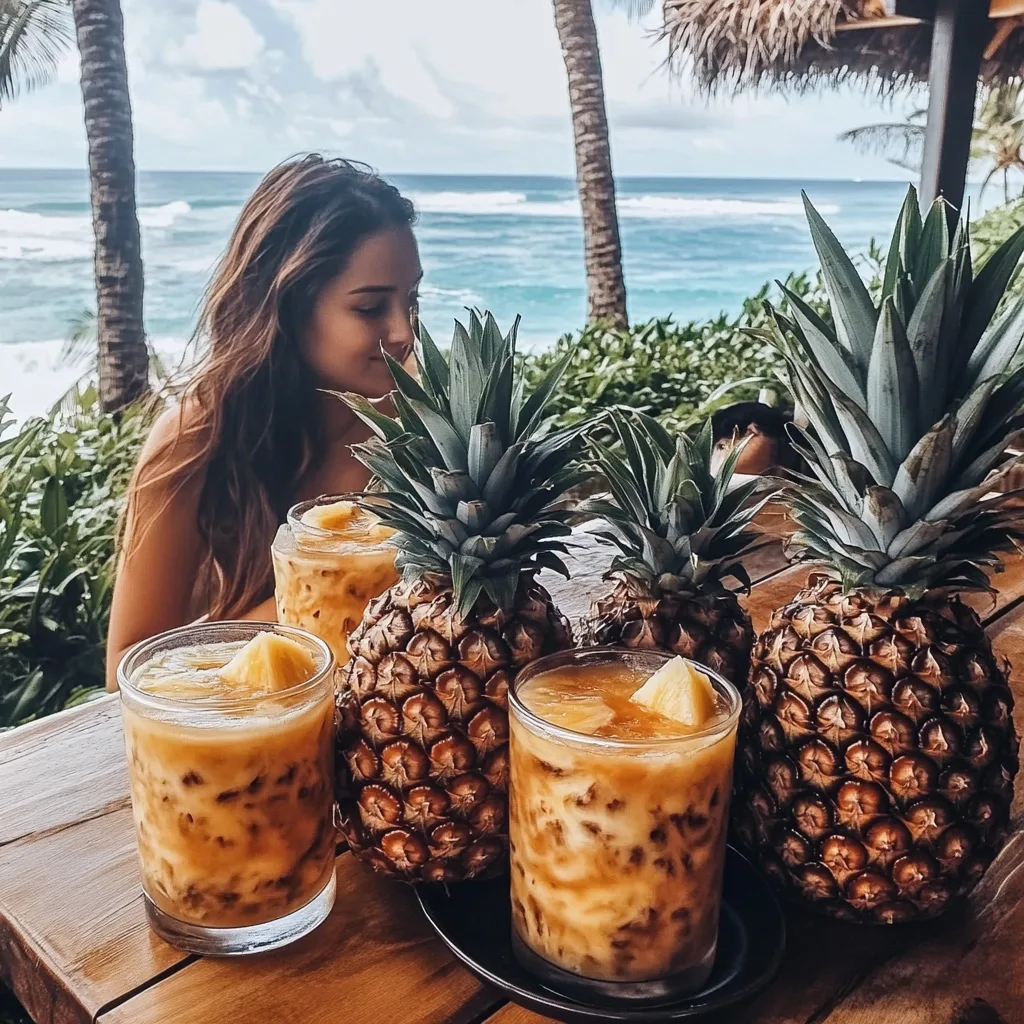Hawaiian food—oh, where do we even begin? You’ve probably heard about it, maybe even tasted it, and wondered: What makes Hawaiian food different from the usual dishes you find around the world? Well, if you thought it was just about pineapples and tiki torches, think again. Hawaiian cuisine is a fusion of influences, local ingredients, and a culture that’s as unique as the islands themselves. Whether it’s the volcanic soil, the pristine beaches, or the ever-present sunshine, there’s more to Hawaiian food than meets the eye. Let’s break down why Hawaiian food stands out and explore the various elements that make it truly unique.
The Origins of Hawaiian Cuisine: Where Everything Began
When you ask, What makes Hawaiian food different? one of the first things you need to consider is its origins. Hawaiian cuisine didn’t just pop up one day; it has roots that stretch across centuries. The indigenous Hawaiians initially relied on their rich natural resources, like fish, taro, and sweet potatoes. Over time, this native cuisine began to blend with influences brought by explorers, immigrants, and colonists, creating a true melting pot of culinary traditions.
The Polynesians, who first arrived in Hawaii around 1,500 years ago, brought with them staples like taro, coconuts, and breadfruit. These ingredients became the foundation of Hawaiian dishes. As the islands saw an influx of other cultures—like Japanese, Portuguese, Chinese, and Filipino—Hawaiian food became a vibrant fusion of flavors. So, if you thought Hawaiian food was all about spam and pineapple, well, you’re in for a surprise. There’s a whole lot more going on in that bowl of poi.
Learn more about the history and cultural influences that shaped Hawaiian cuisine in this detailed article on Hawaiian Culinary History
The Role of Geography in Hawaiian Cuisine: Why Location Matters
It’s not just the weather that makes Hawaii special—its geography plays a massive role in the food that gets served on your plate. The volcanic soil, fertile lands, and surrounding ocean create an environment ideal for farming and fishing. So, what makes Hawaiian food different? The fact that its ingredients are incredibly fresh and local. The island’s geography is a natural incubator for a diverse range of crops, from tropical fruits to vegetables, and, of course, seafood.
Hawaii’s unique geography ensures that local products like papayas, pineapples, and coconuts thrive. The ocean, teeming with fish like tuna and mahi-mahi, ensures that seafood is always fresh. That’s right, no need for frozen fish sticks here—Hawaiian food is as fresh as it gets, thanks to the surrounding Pacific waters.
Cultural Fusion in Hawaiian Dishes: It’s Like a Global Buffet, But Better
If you’re still wondering what makes Hawaiian food different, it’s the way cultures from around the world have contributed to its evolution. As Hawaii became a melting pot of cultures, its food naturally evolved into a fusion of flavors. The Japanese introduced rice and sushi, the Portuguese brought sausage and malasadas, and the Chinese contributed chow mein and fried rice.
Thanks to these cultural influences, Hawaiian food became an eclectic blend of ingredients and techniques. Imagine a plate of loco moco: rice, a hamburger patty, fried egg, and gravy. Now try finding that combination anywhere else. It’s like the culinary equivalent of a family reunion where everyone brought their best dish. And somehow, they all go together perfectly.
Staple Ingredients That Define Hawaiian Food: Pineapple’s Got Nothing on These
Sure, pineapples are famous, but what makes Hawaiian food different is the variety of ingredients that make it unique. Some ingredients, like taro, are so deeply ingrained in Hawaiian culture that they hold spiritual significance. Taro is not just food—it’s a part of Hawaiian heritage. It’s used to make poi, a traditional dish that’s often eaten with fish, meats, or other local staples.
Other essential ingredients include sweet potatoes, breadfruit, and fish. Don’t forget about the meats—like pork, which is commonly cooked in a traditional underground oven called an imu. It’s not just about the pineapple on your plate; it’s about the harmonious combination of local produce, fish, and meats that create the signature taste of Hawaiian cuisine.
Unique Cooking Techniques in Hawaiian Cuisine: Imu, Poke, and More
If you’ve ever wondered what makes Hawaiian food different, you need to take a closer look at their cooking methods. Hawaiian cuisine isn’t just about the ingredients—it’s also about how those ingredients are prepared. Take the imu, for example: a traditional underground oven used to slow-cook pork for hours until it’s tender and smoky. It’s not just cooking; it’s an experience, as the food is buried underground, cooked by hot rocks and steam.
Then there’s poke. What makes Hawaiian food different with poke is how versatile it is. Poke consists of raw fish, often seasoned with soy sauce, sesame oil, and seaweed. But depending on the region or chef, you might find poke served with a wide range of toppings, from avocado to chili flakes. This method of preparing fish is as traditional as it gets, but it’s also a blank canvas for endless creativity.
Iconic Hawaiian Dishes: Beyond Pineapple
When you think of Hawaiian food, you might picture a luau feast with roasted pig, pineapple, and coconut drinks. But there’s so much more to the island’s cuisine. What makes Hawaiian food different is the iconic dishes that have become synonymous with the culture. From the aforementioned loco moco to spam musubi, these dishes are a reflection of Hawaii’s multicultural influences.
Spam musubi, a popular snack, combines the beloved canned meat with rice and a sheet of nori (seaweed). It’s the culinary equivalent of comfort food that’s both satisfying and a little quirky. And then there’s haupia—coconut pudding that’s served at luaus and special occasions. These dishes, though simple, carry the island’s essence in every bite.
Influence of the Plantation Era on Hawaiian Food: Sweet and Savory, With a Side of History
So, what makes Hawaiian food different? The plantation era in Hawaii played a huge role in shaping the cuisine we know today. During the 19th and early 20th centuries, sugar plantations brought in workers from China, Japan, Portugal, and the Philippines. These workers brought their culinary traditions with them, which then mingled with native Hawaiian dishes.
This era gave birth to dishes like adobo, lumpia, and fried rice, all of which can still be found in Hawaiian cuisine today. What makes Hawaiian food different is how it combines these influences with traditional Hawaiian cooking methods, creating a cuisine that’s as diverse as the people who shaped it.
Modern Hawaiian Food Trends: Fusion or Tradition?
Today, Hawaiian food is continuing to evolve. If you’re wondering what makes Hawaiian food different, it’s the way it’s embraced modern culinary trends without losing its roots. From poke bowls to acai bowls, contemporary Hawaiian cuisine is all about fresh ingredients, sustainability, and creative interpretations of traditional dishes.
With the rise of food trucks, fusion restaurants, and pop-up eateries, modern Hawaiian food is making waves both locally and globally. Whether it’s blending traditional flavors with international spices or reinventing the classics, Hawaiian food today is as dynamic as ever.
Hawaiian Desserts and Sweets: Sugar, Coconut, and the Aloha Touch
Let’s talk about sweets. If you’re still asking what makes Hawaiian food different, the answer may lie in the island’s desserts. Coconut, sugar, and tropical fruits are key ingredients in many Hawaiian sweets. From haupia (coconut pudding) to malasadas (Portuguese doughnuts), the desserts here are as irresistible as they are diverse.
What makes Hawaiian food different in the dessert world is the fusion of native and immigrant influences. The islands’ desserts not only capture the tropical flavors of Hawaii but also reflect its multicultural heritage. Just try saying no to a fresh coconut cream pie or a slice of banana bread—you’ll find it impossible.
The Significance of Aliment in Hawaiian Culture: It’s More Than Just Eating
Food in Hawaii isn’t just about nourishment; it’s an integral part of the culture. What makes Hawaiian food different is how deeply it’s embedded in the island’s history and values. Food is a way to honor ancestors, connect with nature, and bring people together. It’s no wonder that sharing a meal at a family gathering or community luau is such a treasured tradition.
From ancient feasts to modern-day celebrations, food is central to Hawaiian life. It’s about respect for the land, for the ocean, and for each other. In Hawaii, food is not just something you eat; it’s a way of showing love, respect, and community.
Hawaiian Macaroni Salad Recipe
While exploring Hawaiian cuisine, the locally sourced pineapples add an extra layer of authenticity to dishes like Hawaiian macaroni salad, blending traditional ingredients with the island’s signature fruit.
The Importance of Aloha Spirit in Hawaiian Cuisine: Cooking With Heart
If you’re still wondering what makes Hawaiian food different, it’s the Aloha spirit. The Aloha spirit isn’t just a tourist marketing slogan; it’s the heart and soul of Hawaii. The Aloha spirit infuses everything the islanders do, including food. When someone prepares a meal in Hawaii, they’re not just cooking—they’re sharing a piece of themselves, their culture, and their history.
It’s this spirit of warmth and hospitality that makes Hawaiian food feel special. When you sit down to eat, you’re not just enjoying a meal; you’re part of something larger—a community that celebrates life, love, and the land.
How Hawaiian Food Differs From Other Pacific Cuisines: Not All Islands Are Created Equal
While many Pacific Island nations share some culinary similarities, what makes Hawaiian food different is its combination of native ingredients, immigrant influences, and unique cooking techniques. Sure, you’ll find some overlap with other Pacific cuisines, but Hawaii’s food is distinct in its flavors, preparations, and cultural significance.
Whether it’s the abundant use of fresh fish, the influence of plantation-era dishes, or the unique combination of tropical fruits, Hawaiian food stands out as a category of its own.
Hawaiian Drinks and Beverages: Sip on Some Paradise
No article about Hawaiian food would be complete without mentioning the beverages. What makes Hawaiian food different in the drink department? Well, it’s all about tropical fruits, fresh juices, and, of course, the famous Mai Tai cocktail. Whether you’re sipping on coconut water straight from the shell or enjoying a tropical smoothie made from locally grown fruits, Hawaiian drinks are as refreshing as they come.
Exploring Hawaiian Aliment in Local and Global Markets: Spreading the Aloha Worldwide
Thanks to its growing popularity, Hawaiian food has gone global. If you’ve ever wondered what makes Hawaiian food different in the world’s markets, it’s the way it blends tradition with innovation. From poke bowls in trendy urban restaurants to spam musubi in convenience stores across the U.S., Hawaiian food is making its mark.
Local chefs and food trucks are bringing the flavors of Hawaii to a global audience, and people are falling in love with the sweet, salty, and smoky tastes of the islands.
FAQs About Hawaiian Aliment: Your Burning Questions Answered
If you still have questions about what makes Hawaiian food different, don’t worry. Here are some of the most frequently asked questions:
- Is Hawaiian aliment healthy? Yes, when it focuses on fresh fish, fruits, and vegetables.
- What’s the deal with Spam? Spam is a beloved, nostalgic snack that has become a Hawaiian staple.
- Can you find Hawaiian aliment outside of Hawaii? Absolutely! Thanks to its popularity, many places around the world now serve Hawaiian-inspired dishes.
Conclusion: The Answer to What Makes Hawaiian Aliment Different?
In the end, what makes Hawaiian food different is a combination of history, geography, culture, and an undeniable love for fresh, local ingredients. From the influence of ancient Polynesian traditions to modern-day fusion trends, Hawaiian aliment is a unique reflection of the islands’ diverse heritage. Whether you’re digging into a plate of poke, savoring some spam musubi, or enjoying a refreshing tropical drink, you’re tasting a piece of Hawaii itself. And trust us, there’s no other place quite like it.


2 thoughts on “What Makes Hawaiian Food Different?”